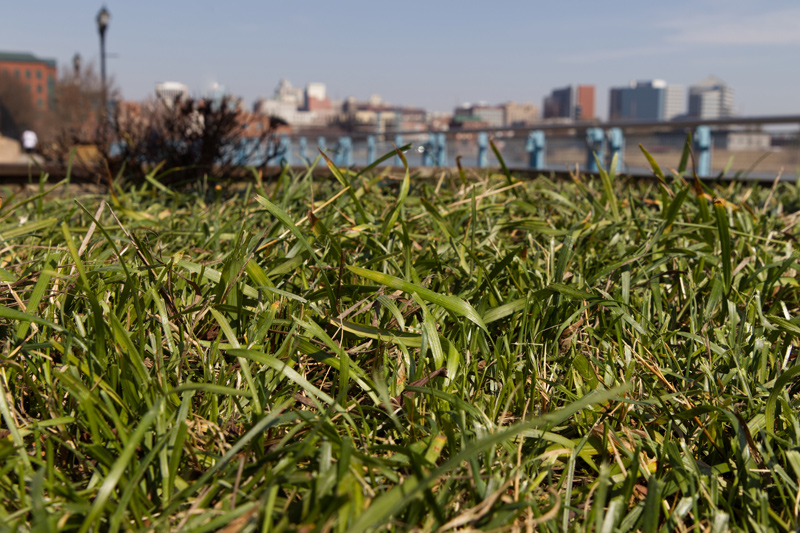


Backyard carbon
Photos by Monica Moriak and courtesy of Andrew Hill March 29, 2021
Researchers quantify carbon emissions from lawns and lawn maintenance in cities
To witness the carbon cycle in action, many homeowners need look no further than their own backyards. Literally. An appealing alternative to concrete or asphalt, a grassy manicured lawn is a popular landscape choice that has now attracted the interest of urban ecologists seeking to better quantify carbon emissions in cities across the world.
The ultimate goal of urban ecology is to balance human socioeconomic needs with the natural environment. Understanding how much carbon is stored or emitted by lawns is a critical area of study, as is knowing how that might change across cities of varying size, density and climate. Researchers from the University of Delaware’s Department of Plant and Soil Sciences, part of the College of Agriculture and Natural Resources, pursue answers to these questions in recently published studies of lawns and lawn maintenance in Baltimore and Singapore.
“Scientists have built a strong knowledge base regarding the various processes and controls affecting carbon cycling and much of this literature comes from natural ecosystems such as temperate and boreal forests which are incredibly important for the global carbon cycle,” said Andrew Hill, UD graduate student and lead author of the Baltimore study. “Our work highlights that within highly anthropogenic systems such as cities and suburbs, factors regulating natural carbon cycling can become altered from changes in environmental conditions such as urban heat island effects, modified hydrology, soil disturbance and land development.”

In Baltimore, Hill and colleagues monitored carbon levels with equipment consisting of a series of automated chambers linked by a system multiplexer and a central infrared gas analyzer. This state-of-the-art equipment measures the concentration change in carbon dioxide as the chamber lowers into the soil for a set measurement period and an infrared analyzer determines the concentration based on an absorbance spectra.
“We collected emissions data every half hour, day and night, for over four years. We used these continuous high frequency measurements to build statistical models for each meteorological season because we wanted to identify patterns and key drivers influencing emissions rates in the context of seasonality,” said Hill. “This level of continuous measurement provides unprecedented detail which is required to fully understand patterns and processes of natural carbon emissions.”
The team compared the data from Baltimore lawns to information collected from adjacent suburban forest floors under the same environmental conditions. They found that lawns can emit over 1 kilogram of carbon per square meter per year, an amount larger than that emitted from forest floors, suggesting that urban lawns may be an important source of carbon to the atmosphere.

Quantifying the carbon emissions from lawns is only one piece of the puzzle, though. Scientists also must quantify the carbon stored in the soil, roots and leaves of the grass. There is also regular management like irrigation, pruning and mowing required to maintain a healthy lawn.
In a collaborative study from the National University of Singapore, the Center for Urban Greenery and Ecology (part of Singapore’s National Parks Board, called NParks), and the University of Delaware, scientists considered these variables to quantify the total carbon balance. Funded by the National Research Foundation Singapore and NParks, this study accounted for gas emissions from mowers and various greenery management techniques in Singapore and found that lawns act as a net carbon emission into the atmosphere.
“Many cities are developing policies to promote greenery to offset anthropogenic emissions. Depending on the greenery management, any carbon gain may be lost, and green areas may end up acting as emission sources of atmospheric carbon dioxide at city scale,” said Erik Velasco, lead author of the Singapore study and international colleague of UD researchers. “Holistic assessments that consider all gains and losses are needed to devise effective mitigation measures against climate change through an improved greenery management plan, as well as not to oversize the carbon sequestration potential of urban landscapes.”

The results of these studies are expected to provide insight into improving urban landscape design and greenery management practices that fully consider the biogeochemical processes occurring in plants and soil. Although carbon emissions from grassy lawns at homes and in parks represent a small fraction of the total greenhouse gas emissions, it is still important to identify and implement gardening practices that promote carbon storage and reduce the impact of maintenance activities. Choosing efficient machinery and timing mowing frequency to optimize turfgrass health instead of aesthetic appearance could reduce emissions from lawnmowers. Using clippings and greenery waste as compost or leaving them in place could also help minimize greenhouse gas emissions and make urban lawns a more environmentally-friendly landscape choice.
Rodrigo Vargas, associate professor, Earth Leadership Fellow and co-author of both studies, notes that there are many alternatives to a manicured lawn. Planting native plant species that are adapted to local climate, topography and soil conditions could decrease the need for fertilizer, irrigation or other soil quality improvements. Increasing the diversity of green spaces in cities to include forested areas, not just turfgrass, would also increase carbon sequestration.
“We need bold alternatives to decorative grounds such as lawns covered by native and spontaneous vegetation instead of monotonous grass,” said Vargas. “This could reduce the environmental impact of current greenery design and management, and also create dense biodiverse and low-maintenance green plots that could be used and enjoyed by the public for any number of recreational and educational purposes.”
Contact Us
Have a UDaily story idea?
Contact us at ocm@udel.edu
Members of the press
Contact us at 302-831-NEWS or visit the Media Relations website

